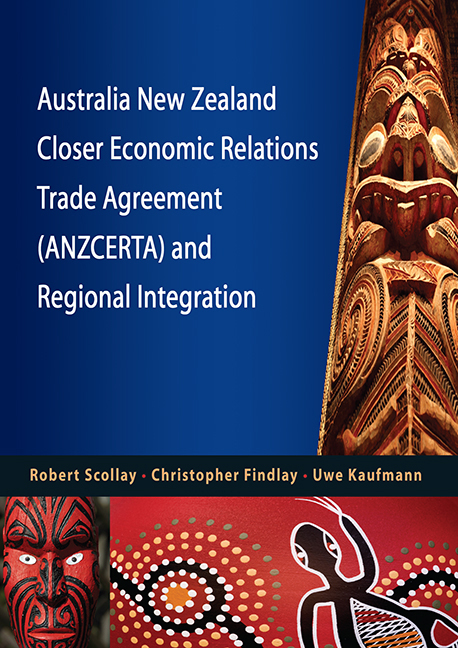Book contents
- Frontmatter
- Contents
- Foreword
- Australia New Zealand Closer Economic Relations Trade Agreement (Anzcerta) and Regional Integration
- Executive Summary
- 1 Introduction
- 2 Background
- 3 Pre-ANZCERTA Trade Arrangements
- 4 Early Years of ANZCERTA
- 5 Consolidation of ANZCERTA
- 6 Deepening Integration
- 7 Pursuit of a Single Economic Market (SEM)
- 8 Further Monetary Integration: A Monetary Union?
- 9 The Economic Effects of ANZCERTA
- 10 Conclusion
- References
- About the Authors
9 - The Economic Effects of ANZCERTA
from Australia New Zealand Closer Economic Relations Trade Agreement (Anzcerta) and Regional Integration
Published online by Cambridge University Press: 21 October 2015
- Frontmatter
- Contents
- Foreword
- Australia New Zealand Closer Economic Relations Trade Agreement (Anzcerta) and Regional Integration
- Executive Summary
- 1 Introduction
- 2 Background
- 3 Pre-ANZCERTA Trade Arrangements
- 4 Early Years of ANZCERTA
- 5 Consolidation of ANZCERTA
- 6 Deepening Integration
- 7 Pursuit of a Single Economic Market (SEM)
- 8 Further Monetary Integration: A Monetary Union?
- 9 The Economic Effects of ANZCERTA
- 10 Conclusion
- References
- About the Authors
Summary
This penultimate section of the report surveys the evidence from studies of the economic effects of ANZCERTA.
Approaches to Assessing FTA Effects
Most studies of the economic effects of ANZCERTA have focused on its impact on trade, typically the impact on merchandise trade, usually with a view to deriving estimates, or more commonly inferences, as to its impact on the overall economic welfare of the partners. As with all analyses of FTAs and other forms of preferential trade agreement, the analysis of the economic effects of ANZCERTA has typically focused on the relative strength of trade creation and trade diversion effects, as the first step towards reaching conclusions regarding overall welfare effects.
The removal of tariffs (and other trade barriers) on trade between the FTA members allows each member's goods to be sold in its partner's market at a lower price than previously. Some products that were uncompetitive in the partner market when they were subject to the partner country's tariff will become competitive when that tariff is removed under the FTA, giving rise to increased intra-FTA trade in the form of imports by the partner country of these products that are newly competitive in its market.
The increased intra-FTA trade can be divided into three parts. One part simply involves the replacement of imports from previous foreign suppliers (who would remain the most competitive suppliers of imports if the tariff continued to be applied to products from all sources). This is trade diversion. A second part involves the replacement of less efficient domestic production in the partner by the more competitive imports from the other FTA member, while the third part reflects the increased overall purchasing by consumers in response to the lower prices. Trade creation is the combination of these latter two parts: it is the amount of increased intra-FTA trade that does not simply consist of trade diversion.
Trade creation (sometimes described, more precisely, as net trade creation) yields a welfare gain to the importing member, the size of which depends both on the amount of trade created, and on the extent of the price fall in the domestic market of the importing member, brought about by the entry of duty-free imports from the partner.
- Type
- Chapter
- Information
- Australia New Zealand Closer Economic Relations Trade Agreement (ANZCERTA) and Regional Integration , pp. 70 - 99Publisher: ISEAS–Yusof Ishak InstitutePrint publication year: 2010



